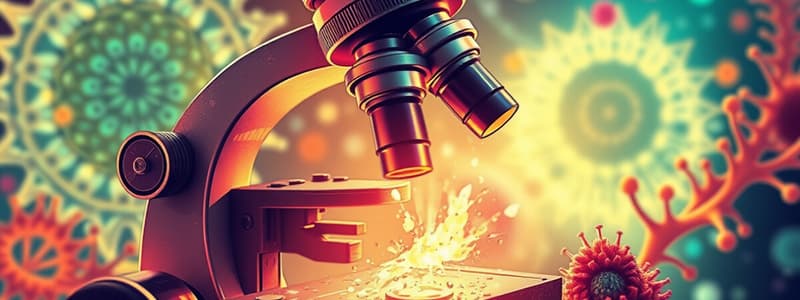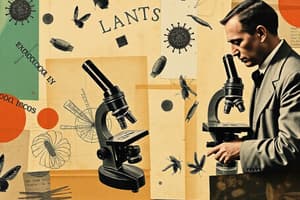Podcast
Questions and Answers
What significant warning did Alexander Fleming issue in 1945 regarding antibiotics?
What significant warning did Alexander Fleming issue in 1945 regarding antibiotics?
- The potential for increased drug prices
- The possibility of antibiotics causing new diseases
- The need for wider distribution of antibiotics
- The risk of microorganism resistance due to excessive use (correct)
Which area of microbiology has been notably advanced by recombinant DNA technology?
Which area of microbiology has been notably advanced by recombinant DNA technology?
- The study of infectious diseases exclusively
- The development of vaccines only
- Quality control measures in pharmaceutical labs
- Advancements across various domains of microbiology (correct)
What is a primary contribution of microbiology to the pharmaceutical industry?
What is a primary contribution of microbiology to the pharmaceutical industry?
- Production of antiseptics
- Development of pain relief medications
- Discovery of antibiotics from microbial metabolism (correct)
- Creation of enhancements to traditional vitamins
What is a necessary process for producing vaccines against bacterial diseases?
What is a necessary process for producing vaccines against bacterial diseases?
What aspect of microbiology is essential for ensuring the quality control of pharmaceutical products?
What aspect of microbiology is essential for ensuring the quality control of pharmaceutical products?
What was the significance of Robert Hooke's observation in 1665?
What was the significance of Robert Hooke's observation in 1665?
Which scientist first described spermatozoa using a single lens microscope?
Which scientist first described spermatozoa using a single lens microscope?
What observation did Francesco Redi make in his 1668 experiment?
What observation did Francesco Redi make in his 1668 experiment?
Which of the following best defines 'spontaneous generation'?
Which of the following best defines 'spontaneous generation'?
Which scientist proposed a challenge to spontaneous generation with the concept of biogenesis in 1858?
Which scientist proposed a challenge to spontaneous generation with the concept of biogenesis in 1858?
What did Anton van Leeuwenhoek call the microorganisms he first observed?
What did Anton van Leeuwenhoek call the microorganisms he first observed?
What was John Needham's conclusion from his experiment with nutrient fluids?
What was John Needham's conclusion from his experiment with nutrient fluids?
What was a common misconception about the origin of life before the second half of the 19th century?
What was a common misconception about the origin of life before the second half of the 19th century?
Who is commonly attributed with the invention of the microscope?
Who is commonly attributed with the invention of the microscope?
What key feature did the Janssen microscope, dated to 1595, have?
What key feature did the Janssen microscope, dated to 1595, have?
What term did Robert Hooke coin while observing cork under the microscope?
What term did Robert Hooke coin while observing cork under the microscope?
In which year did Galileo Galilei improve the microscope design?
In which year did Galileo Galilei improve the microscope design?
What was the primary focus of Galileo's scientific interests as mentioned?
What was the primary focus of Galileo's scientific interests as mentioned?
What is a key detail mentioned about Hans Lippershey?
What is a key detail mentioned about Hans Lippershey?
Which publication detailed Hooke's observations of microscopic structures?
Which publication detailed Hooke's observations of microscopic structures?
What argument do some historians make regarding Hans Janssen's role in microscope development?
What argument do some historians make regarding Hans Janssen's role in microscope development?
What is the primary purpose of using microbes in bioremediation?
What is the primary purpose of using microbes in bioremediation?
Which bacterium is commonly used to control agricultural insect pests?
Which bacterium is commonly used to control agricultural insect pests?
Which of the following bacteria is known for its use in the production of curd in milk?
Which of the following bacteria is known for its use in the production of curd in milk?
What role do rhizobium and cyanobacteria play in agriculture?
What role do rhizobium and cyanobacteria play in agriculture?
What is one application of recombinant DNA technology beyond its medical uses?
What is one application of recombinant DNA technology beyond its medical uses?
Which field of microbiology focuses on pathogens and the body's defenses?
Which field of microbiology focuses on pathogens and the body's defenses?
What was the significant contribution of Dmitri Iwanowski in the field of virology?
What was the significant contribution of Dmitri Iwanowski in the field of virology?
Which of the following fields involves the study of microbes in soil formation?
Which of the following fields involves the study of microbes in soil formation?
Who were the pioneers that demonstrated how bacteria recycle vital elements?
Who were the pioneers that demonstrated how bacteria recycle vital elements?
What is the primary role of sewage treatment plants?
What is the primary role of sewage treatment plants?
Which type of microbiology deals with sewage waste management and water purification?
Which type of microbiology deals with sewage waste management and water purification?
What is the main focus of microbial physiology and genetics?
What is the main focus of microbial physiology and genetics?
Which statement about microorganisms is true?
Which statement about microorganisms is true?
Flashcards are hidden until you start studying
Study Notes
History of the Microscope
- The first microscope was invented around 1590, with disputing claims of inventors.
- Hans Lippershey, noted for his telescope patent in the 1570s, and Hans and Zacharias Janssen of Middelburg are prime candidates.
- The Janssens were attributed the invention due to correspondence from diplomat William Boreel in the 1650s.
- The Janssen microscope, dated to 1595, featured three sliding tubes and could magnify 3-9 times.
- Galileo improved microscope design in 1609, referring to it as an occhiolino, and later used his design for telescopic observations.
- Robert Hooke, in 1665, coined the term "cell" based on his observations in cork, leading to the Cell Theory.
- Anton van Leeuwenhoek, in the 1670s, employed single-lens microscopes to discover sperm and various microorganisms, calling them "animalcules."
- In 1882, Robert Koch identified Mycobacterium tuberculosis, a significant milestone in microbiology.
Theories on Origin of Life
- Spontaneous generation hypothesized that life could arise from non-living matter, prevalent until the 19th century.
- Francesco Redi's 1668 experiment demonstrated that maggots on decaying meat originated from eggs laid by flies.
- John Needham's 1745 findings showed that nutrient fluids teemed with microorganisms after boiling and cooling.
- Lazaro Spallanzani countered with sealed experiments to show that microorganisms came from air, not spontaneous processes.
- Rudolf Virchow introduced biogenesis in 1858, asserting that life arises from pre-existing life.
Antibiotics Discovery
- Alexander Fleming discovered penicillin in 1928, paving the way for antibiotic development.
- In 1945, Fleming warned about potential resistance of microorganisms due to antibiotic misuse.
Modern Developments in Microbiology
- Current research includes AIDS studies, interferon analysis, and vaccine development.
- Advancements in molecular biology and electron microscopy have enhanced understanding in virology.
- Recombinant DNA technology has revolutionized the field, aiding various microbiological studies.
Applications in Pharmaceuticals
- Microbiology crucially contributes to the pharmaceutical industry via antibiotic and vaccine production.
- Steroids can be sourced from microorganisms as well.
- Quality control in pharmaceuticals prevents microbial contamination in injectable and topical products.
General and Specialized Fields
- Key fields include bacteriology, virology, mycology, parasitology, and immunology.
- Specialized branches cover medical, veterinary, agricultural, sanitary, industrial microbiology, and environmental microbiology.
Role of Microbes in Human Welfare
- Most microorganisms are beneficial, contributing to health and ecosystem stability, despite some causing spoilage.
- Microbes recycle vital elements, with Beijerinck and Winogradsky recognizing their role in nutrient cycling.
Environmental Applications
- Sewage treatment utilizes microbes to remove harmful substances and recycle water, converting waste into beneficial by-products.
- Bioremediation began in 1988, employing certain bacteria like Pseudomonas and Bacillus to clean pollutants.
Agricultural and Pest Control
- Bacillus thuringiensis is used to control agricultural pests effectively without harmful effects on crops or humans.
Biotechnology and Gene Therapy
- Recombinant DNA techniques promise advancements in gene therapy and agricultural improvements.
Industrial Applications
- In food production, Lactobacillus aids in curd formation, Saccharomyces cerevisiae is vital for baking and beverage fermentation, and Propionibacterium is used for Swiss cheese production.
- Biofertilizers like Rhizobium and mycorrhiza improve soil nutrients and plant health.
Studying That Suits You
Use AI to generate personalized quizzes and flashcards to suit your learning preferences.




